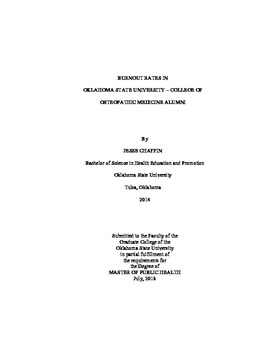| dc.contributor.advisor | Wheeler, Denna L. | |
| dc.contributor.author | Chaffin, Jesse | |
| dc.date.accessioned | 2019-03-25T20:05:27Z | |
| dc.date.available | 2019-03-25T20:05:27Z | |
| dc.date.issued | 2018-07-01 | |
| dc.identifier.uri | https://hdl.handle.net/11244/317709 | |
| dc.description.abstract | Today's public health workforce is operating at maximum capacity while experiencing a tremendous shortage in physicians nationwide. Physician burnout is causing threats to the care continuum with increases in medical errors, decreased quality of patient care, and physicians leaving the field all together. Physician burnout rates are growing each year. Burnout rates in the allopathic community has been heavily studied. There are few studies that examine burnout rates in osteopathic physicians. | |
| dc.description.abstract | I conducted a survey based study of Oklahoma State University - College of Osteopathic alumni. This exploratory study used convenience sampling to estimate burnout rates among osteopathic physicians and identified relationships of burnout among demographic variables and practice characteristics. | |
| dc.description.abstract | Of 2,134 email invitations sent to alumni, 409 (19%) responded to the survey. When assessed using the Maslach Burnout Inventory - Human Services Survey, 70.7% of physicians reported at least 1 manifestation of burnout. Burnout rates varied among demographic categories, but only gender and race were found to be statistically significant. In terms of gender, more females (78%) than males (67%) were experiencing burnout. In relation to race/ethnicity, African American and White were similar with burnout rates around 75% and the Hispanic population experienced the lowest at 25%. There were no other significant relationships identified. Burnout rates of the sample were high compared to the national range (71% vs. 22 - 76%). Emotional exhaustion was determined to be higher than the national range (66% vs. 20 - 47%). Depersonalization was high compared to the national range (46% vs. 13 - 50%). Sense of personal accomplishment was much higher compared to the national range (90% vs. 12 - 61%). | |
| dc.description.abstract | Results from this study indicate that burnout rates are high in OSU COM alumni. Additional research is needed to assess burnout rates among a larger population of osteopathic physicians. Specifically, additional research is needed to fully explore the relationship between all three constructs of burnout, (emotional exhaustion, depersonalization, and personal accomplishment), and determine if increased personal accomplishment affects the effects of burnout. Research is also needs to be initiated on outcome driven wellness programming with efforts at reducing burnout in physicians. | |
| dc.format | application/pdf | |
| dc.language | en_US | |
| dc.rights | Copyright is held by the author who has granted the Oklahoma State University Library the non-exclusive right to share this material in its institutional repository. Contact Digital Library Services at lib-dls@okstate.edu or 405-744-9161 for the permission policy on the use, reproduction or distribution of this material. | |
| dc.title | Burnout Rates in Oklahoma State University - College of Osteopathic Medicine Alumni | |
| dc.contributor.committeeMember | Hubach, Randolph D. | |
| dc.contributor.committeeMember | Croff, Julie May | |
| osu.filename | Chaffin_okstate_0664M_15918.pdf | |
| osu.accesstype | Open Access | |
| dc.description.department | Public Health | |
| dc.type.genre | Thesis | |
| dc.type.material | text | |
